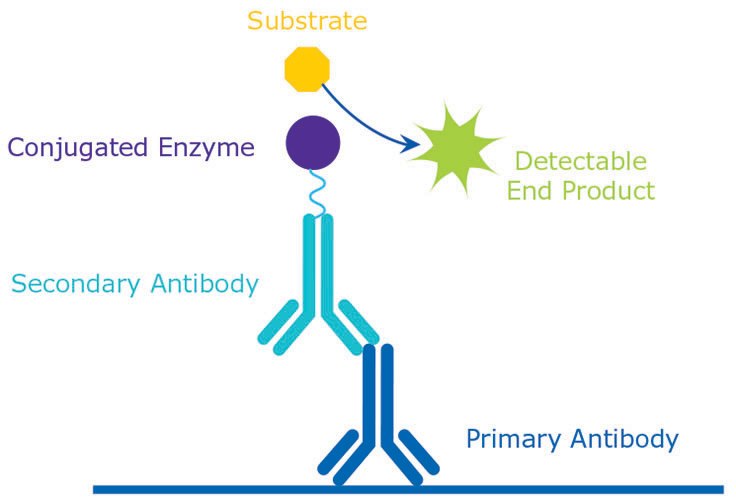Using Conjugated and Secondary Antibodies
Conjugated Antibodies
Often for signal amplification and detection purposes, purified antibodies are conjugated to enzymes, fluorophores, or haptens, such as horseradish peroxidase (HRP), alkaline phosphatase (AP), rhodamine, fluorescein isothiocyanate (FITC), or biotin. The various antibody conjugates have differential stabilities and require different buffers and storage conditions to retain their maximal activity. The list below provides the standard antibody buffers and storage conditions for purified antibodies and antibody conjugates. Note that these are general guidelines. Always consult the datasheet accompanying the antibody for specific storage conditions for each specific antibody.
Antibody Buffers
- Affinity-purified Monoclonal and Polyclonal Antibodies: 0.02 M phosphate buffer, 0.25 M NaCl, 0.1% NaN3, pH 7.6 Same buffer without NaN3 may be used as required.
- FITC Conjugates: 0.02 M phosphate buffer, 0.25M NaCl, 15 mg/mL BSA, 0.1% NaN3, pH 7.6
- HRP Conjugates: 0.01 M PBS, 15 mg/mL BSA, 0.01% thimerosal, pH 7.1
- Alkaline-phosphatase Conjugates: 0.05 M Tris, 0.1 M NaCl, 0.001 M MgCl2, 15 mg/mL BSA, 0.1% NaN3, pH 8.0
- Biotinylated Conjugates: 0.01 M PBS, 15 mg/mL BSA, 0.1% NaN3, pH 7.1

Figure 1.Principle Antigen Detection
Secondary Antibodies
Secondary antibodies are often used to indirectly detect an antigen to which a primary antibody is first bound. Hence, it is important to select a secondary antibody that has specificity for the antibody species and isotype of the primary antibody and is conjugated to a detectable tag or label for detection. Consider the following points:
- The detectable tag could be an enzyme or a fluorochrome. Most commonly used tags are horseradish peroxidase, alkaline phosphatase, fluorescein isothiocyanate (FITC), rhodamine, Texas Red, phycoerythrin, and biotin.
- A proper selection of secondary antibody can improve staining and minimize false positive or negatives.
- Secondary antibodies are used when there are no conjugated primary antibodies available or the primary antibody is not conjugated to a desired enzyme or fluorochrome.
- Secondary antibodies are also used to increase the sensitivity of detection. Even though use of a secondary antibody involves extra steps, it does have the advantage of increased sensitivity due to the signal amplification from multiple secondary antibodies binding to a single primary antibody.
- Secondary antibodies are generated by immunizing a host animal with the antibody from a different species. For example, anti-goat antibodies are raised by injecting goat antibodies into an animal other than a goat. Accordingly, if the primary antibody is raised in mouse, then secondary antibody should be an anti-mouse antibody raised in another species (goat, donkey etc.)
- For ELISA detection, enzyme-conjugated antibodies are the better choice. For flow cytometry, it is best to use a fluorochrome-conjugated secondary antibody.
- A vast majority of primary antibodies belong to the IgG class. They can be detected with the relevant anti-species IgG secondary antibody. If the primary antibody is an IgM, then the secondary antibody specific for IgM should be selected. Selecting an appropriate secondary antibody:
- Secondary antibody should be against the same species in which the primary antibody is raised. For example, if the primary antibody is raised in goat then secondary antibody should be anti-goat.
- Select an antibody labeled with a fluorochome or enzyme of your choice, and your expertise and the instruments available in your laboratory. More commonly used fluorochrome labels are fluorescein, rhodamine, Texas Red, phycoerythrin, etc, and enzyme conjugates could be horseradish peroxidase, alkaline phosphatase, etc.
- Biotin-conjugated antibodies paired with an avidin- or streptavidin-conjugated enzyme or fluorophore provide a more amplified signal when compared to fluorochrome- or enzyme-conjugated secondary antibodies.
- For best results, use a secondary antibody that has been preadsorbed with serum from the same species as the sample, which often reduces the background. However, preadsorbed antibodies may have reduced epitope recognition and may fail to recognize some IgG subclasses.
- Affinity-purified secondary antibodies will provide the least amount of nonspecific binding. However, sometimes IgG fractions are preferred when it contains high affinity antibodies. This is of great advantage when the antigen is present in very low levels.
- Select a secondary antibody that matches the class or subclass of the primary antibody used. For example, if the primary antibody is mouse IgM then it is best to use an anti-mouse IgM secondary.
- When the class or subclass of the primary mouse monoclonal antibody is unknown, then anti-mouse IgG may be used, because it will recognize most of mouse IgG subtypes.
- Secondary Antibodies, Conjugates, and Kits
如要继续阅读,请登录或创建帐户。
暂无帐户?